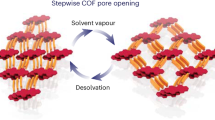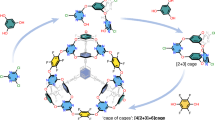Abstract
Synthetic host systems capable of selectively binding guest molecules are of interest for applications ranging from separations and chemical or biological sensing to the development of biomedical materials. Such host systems can be efficiently prepared by ‘imprinting’ polymers or inorganic materials with template molecules, which, upon removal, leave behind spatially arranged functional groups that act as recognition sites1,2,3,4. However, molecularly imprinted polymers have limitations, including incomplete template removal, broad guest affinities and selectivities, and slow mass transfer5,6,7,8. An alternative strategy for moulding desired recognition sites uses combinatorial libraries of assemblies that are made of a relatively small number of molecules, interconverting in dynamic equilibrium; upon addition of a target molecule, the library equilibrium shifts towards the best hosts9,10,11. Here we describe the dynamic imprinting of dendritic macromolecules with porphyrin templates to yield synthetic host molecules containing one binding site each. The process is based on our general strategy to prepare cored dendrimers12,13, and involves covalent attachment of dendrons to a porphyrin core, cross-linking of the end-groups of the dendrons, and removal of the porphyrin template by hydrolysis. In contrast to more traditional polymer imprinting, our approach ensures nearly homogeneous binding sites and quantitative template removal. Moreover, the hosts are soluble in common organic solvents and amenable to the incorporation of other functional groups, which should facilitate further development of this system for novel applications.
This is a preview of subscription content, access via your institution
Access options
Subscribe to this journal
Receive 51 print issues and online access
$199.00 per year
only $3.90 per issue
Buy this article
- Purchase on Springer Link
- Instant access to full article PDF
Prices may be subject to local taxes which are calculated during checkout




Similar content being viewed by others
References
Wulff, G. & Sarhan, A. The use of polymers with enzyme-analogous structures for the resolution of racemates. Angew. Chem. Int. Edn Engl. 11, 341–343 (1972)
Shea, K. J. Molecular imprinting of synthetic network polymers: the de novo synthesis of macromolecular binding and catalytic sites. Trends Polym. Sci. 2, 166–173 (1994)
Andersson, L., Sellergren, B. & Mosbach, K. Imprinting of amino acid derivatives in macroporous polymers. Tetrahedr. Lett. 25, 5211–5214 (1984)
Katz, A. & Davis, M. E. Molecular imprinting of bulk, microporous silica. Nature 403, 286–289 (2000)
Wulff, G. Molecular imprinting in cross-linked materials with the aid of molecular templates—a way towards artificial antibodies. Angew. Chem. Int. Edn Engl. 34, 1812–1832 (1995)
Katz, A. & Davis, M. Investigations into the mechanisms of molecular recognition with imprinted polymers. Macromolecules 32, 4113–4121 (1999)
Sellergren, B. & Shea, K. J. Influence of polymer morphology on the ability of imprinted network polymers to resolve enantiomers. J. Chromatogr. 635, 39–41 (1993)
Vlatakis, G., Andersson, L. I., Muller, R. & Mosbach, K. Drug assay using antibody mimics made by molecular imprinting. Nature 361, 645–647 (1993)
Lehn, J.-M. & Eliseev, A. V. Dynamic combinatorial chemistry. Science 291, 2331–2332 (2001)
Cousins, G. R. L., Poulsen, S.-A. & Sanders, J. K. M. Molecular evolution: dynamic combinatorial libraries, autocatalytic networks and the quest for molecular function. Curr. Opin. Chem. Biol. 4, 270–279 (2000)
Klekota, B. & Miller, B. L. Dynamic diversity and small-molecule evolution: a new paradigm for ligand identification. Trends Biotechnol. 17, 205–209 (1999)
Wendland, M. S. & Zimmerman, S. C. Synthesis of cored dendrimers. J. Am. Chem. Soc. 121, 1389–1390 (1999)
Schultz, L. G., Zhao, Y. & Zimmerman, S. C. Synthesis of cored dendrimers with internal cross-links. Angew. Chem. Int. Edn Engl. 40, 1962–1966 (2001)
Newkome, G. R., Moorefield, C. N. & Vögtle, F. Dendrimers and Dendrons: Concepts, Syntheses, Perspectives (Wiley-VCH, Weinheim, 2001)
Sanders, J. K. M. Templated chemistry of porphyrin oligomers. Compreh. Supramolec. Chem. 9, 131–164 (1996)
Rakow, N. A. & Suslick, K. S. A colorimetric sensor array for odour visualization. Nature 406, 710–714 (2000)
Matsui, J., Higashi, M. & Takeuchi, T. Molecularly imprinted polymer as 9-ethyladenine receptor having a porphyrin-based recognition center. J. Am. Chem. Soc. 122, 5218–5219 (2000)
Ogoshi, H. & Mizutani, T. Novel approaches to molecular recognition using porphyrins. Curr. Opin. Chem. Biol. 3, 736–739 (1999)
Bhyrappa, P., Young, J. K., Moore, J. S. & Suslick, K. S. Dendrimer-metalloporphyrins: synthesis and catalysis. J. Am. Chem. Soc. 118, 5708–5711 (1996)
Dandliker, P. J., Diederich, F., Gisselbrecht, J.-P., Louati, A. & Gross, M. Water-soluble dendritic iron porphyrins: synthetic models of globular heme proteins. Angew. Chem. Int. Edn Engl. 34, 2725–2728 (1996)
Sadamoto, R., Tomioka, N. & Aida, T. Photoinduced electron transfer reactions through dendrimer architecture. J. Am. Chem. Soc. 118, 3978–3979 (1996)
Balzani, V. et al. Dendrimers based on photoactive metal complexes. Recent advances. Coord. Chem. Rev. 219–221, 545–572 (2001)
Hawker, C. J. & Frechet, J. M. J. A new convergent approach to monodisperse dendritic macromolecules. J. Am. Chem. Soc. 112, 7638–7647 (1990)
Trnka, T. M. & Grubbs, R. H. The development of L2X2Ru = CHR olefin metathesis catalysts: an organometallic success story. Acc. Chem. Res. 34, 18–29 (2001)
Coates, G. W. & Grubbs, R. H. Quantitative ring-closing metathesis of polyolefins. J. Am. Chem. Soc. 118, 229–230 (1996)
Adler, A. D. et al. A simplified synthesis of meso-tetraphenylporphyrin. J. Org. Chem. 32, 476 (1967)
Rho, T. & Abuh, F. One-pot synthesis of pyrimidine-5-carboxaldehyde and ethyl pyrimidine-5-carboxylate by utilizing pyrimidin-5-yl-lithium. Synth. Commun. 24, 253–256 (1994)
Collman, J. P. et al. Oxygen binding to cobalt porphyrins. J. Am. Chem. Soc. 100, 2761–2766 (1978)
Acknowledgements
We thank W.A. Goddard and T. Cagin for help with dendrimer modelling. This work was funded by the NIH and the US Army Research Office. I.Z. thanks the Arnold and Mabel Beckman Foundation for a Beckman fellowship.
Author information
Authors and Affiliations
Corresponding author
Ethics declarations
Competing interests
The authors declare that they have no competing financial interests.
Supplementary information
Rights and permissions
About this article
Cite this article
Zimmerman, S., Wendland, M., Rakow, N. et al. Synthetic hosts by monomolecular imprinting inside dendrimers. Nature 418, 399–403 (2002). https://doi.org/10.1038/nature00877
Received:
Accepted:
Issue Date:
DOI: https://doi.org/10.1038/nature00877
This article is cited by
-
Preparation, characterization, and application of soluble liquid crystalline molecularly imprinted polymer in electrochemical sensor
Analytical and Bioanalytical Chemistry (2020)
-
Magnetic Molecularly Imprinted Polymer Combined with High-Performance Liquid Chromatography for the Selective Separation and Determination of Glutathione in Various Wild Edible Boletes
Food Analytical Methods (2019)
-
A star-shaped molecularly imprinted polymer derived from polyhedral oligomeric silsesquioxanes with improved site accessibility and capacity for enantiomeric separation via capillary electrochromatography
Microchimica Acta (2019)
-
Effect of environmental factors on enhanced adsorption and photocatalytic regeneration of molecular imprinted TiO2 polymers for fluoroquinolones
Environmental Science and Pollution Research (2018)
-
Aniline-containing guests recognized by α,α’,δ,δ’-tetramethyl-cucurbit[6]uril host
Scientific Reports (2016)
Comments
By submitting a comment you agree to abide by our Terms and Community Guidelines. If you find something abusive or that does not comply with our terms or guidelines please flag it as inappropriate.



